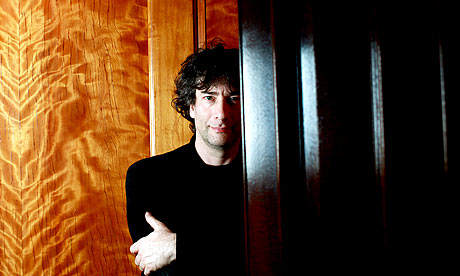
Spell-binding ... Neil Gaiman. Photograph: Graeme Robertson
Neil Gaiman has just won this year's Hugo award for best novel, for The Graveyard Book – and I can't be the only one who isn't surprised by the news. I knew Gaiman was more than just a great writer when I read the comic mini-series Death: The High Cost of Living in 1993. I'd already been blown away by The Sandman, but in the spin-off series featuring Dream's older sister, Death, I found something more. I found a grungy-looking young lad called Sexton, living with a hippie single mother and driven to the brink of suicide by a world in which the World Wrestling Federation could be allowed to exist. Sexton meets Didi, either an orphaned young Goth woman or the personification of Death, who, for one day in every 100 years, must take human form. This story could have been written for me. I was a grungy-looking young lad. I lived with a hippie single mother. Suicide was never far from my muddled teenage thoughts. And boy, did I want to meet a cute Goth girl who thought she was Death. I was under Neil's spell.
I wasn't the first, and I wouldn't be the last. By 1993, Neil had entranced hundreds of thousands of readers with his Sandman stories: their re-mixing of mythology and fairytale, combined with brilliantly observed characters, had attracted an audience that few other writers were reaching. Early graphic novels such as Violent Cases had marked Gaiman as an original voice in comics. The Books of Magic, featuring a bespectacled young boy who discovers his destiny as a great magician, introduced Gaiman to a younger readership, that he would further entrance with novels such as Coraline. Good Omens, written in collaboration with Terry Pratchett, is still a frequent presence on bestseller lists almost two decades after its publication. But it was with the release of American Gods in 2001 that Neil finally captured a mainstream readership. The story of an America populated by all the gods who had ever washed up on its shores, and a war between ancient magic and modern technology, resonated deeply with millions of readers who did not know how much they longed for myth until they were given one.
Neil Gaiman has won over his audience one-by-one with stories in which readers find intense personal meaning. But that audience is now numbered in its millions because of Gaiman's understanding of the primal role of myth in our lives, and our hunger for myths that suit our modern age. His stories stitch together a 21st-century mythology, woven from the legends of ancient Greece and the Norse pantheon, eastern European folktales and the British literary tradition of Milton and Shakespeare, to name just a few of his sources. Into this fabric are embroidered modern mythic figures for our age: Dream and his family of the Endless; the bespectacled boy wizard; and now the child raised by nightmares in a graveyard.
The Graveyard Book is a story that deserves to be told and retold. The tale of Bod, whose parents are murdered and who is raised by the ghosts, ghouls and vampires inhabiting the graveyard where he takes shelter is more than just a spooky tale for children. It's a story for an age in which many people find that family doesn't offer the security they need; a story about the strength and love found in friendship, but also about the need for growth and change that means we must sometimes let go of friendship. It's the kind of tale people tell their children at bedtime. The least we can do to celebrate it is to give the author a prize.



No comments:
Post a Comment